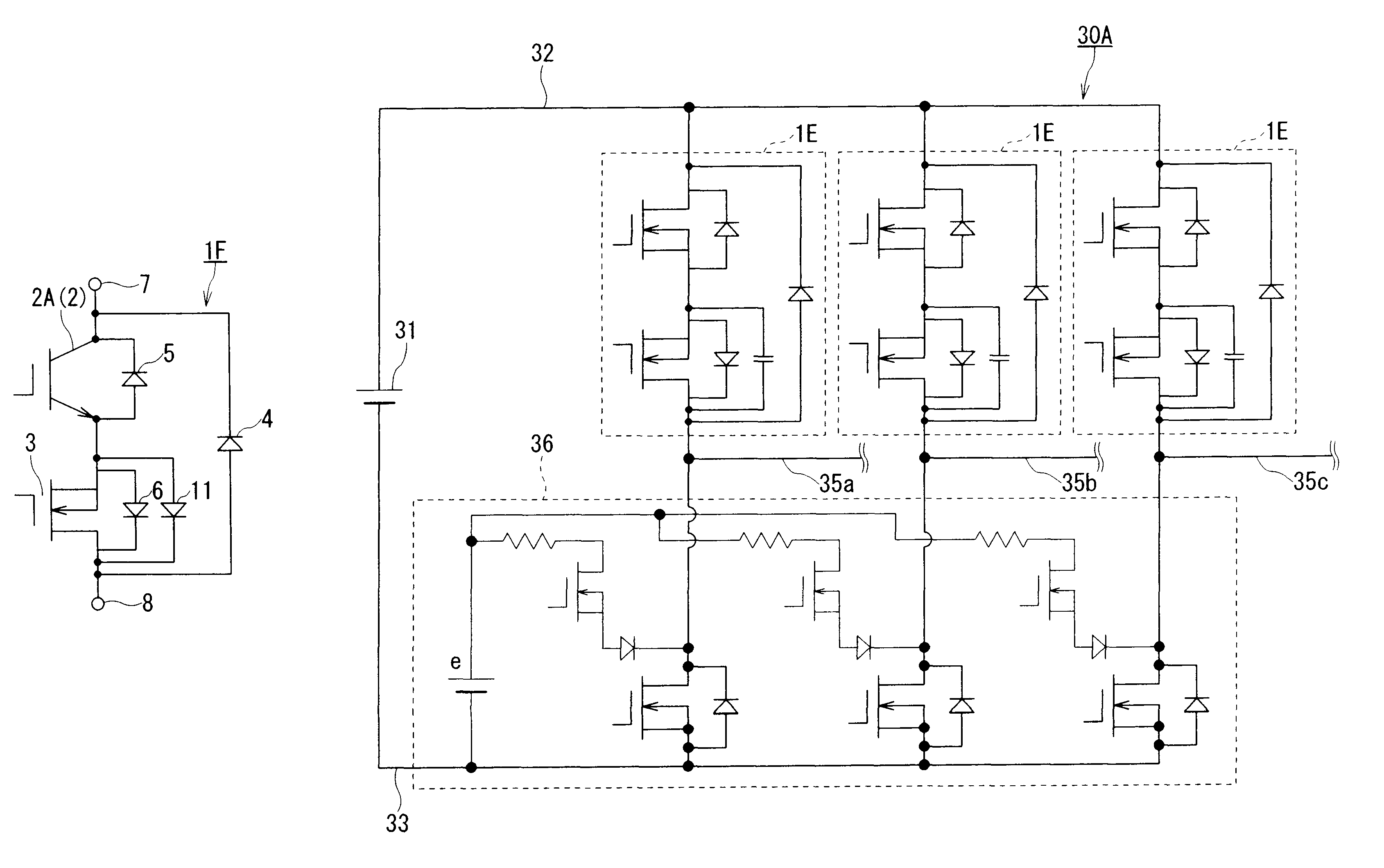Semiconductor switch and power conversion system provided with semiconductor switch
a technology of semiconductor switch and power conversion system, which is applied in the direction of pulse technique, process and machine control, instruments, etc., can solve the problems of increasing the scale of additional circuits, increasing the complexity of circuitry thereof, and increasing the size of auxiliary power supply having a relatively large capacity alkalis, so as to reduce the loss, simplify the circuit configuration, and effectively suppress the reverse recovery current of freewheel diodes
- Summary
- Abstract
- Description
- Claims
- Application Information
AI Technical Summary
Benefits of technology
Problems solved by technology
Method used
Image
Examples
first embodiment
[0033]FIG. 1 is a circuit diagram illustrating a circuit configuration of a semiconductor switch 1A in accordance with a first embodiment of the present invention.
[0034]The semiconductor switch 1A is configured by connecting an auxiliary element 3 in series with a main element 2 serving as a switching element of a commonly-used power conversion circuit and by connecting a high-speed freewheel diode 4 having the same voltage resistance (withstand voltage) as that of the main element 2 in inverse parallel with the series connection of the main element 2 and the auxiliary element 3. That is, the semiconductor switch 1A is configured by adding an additional circuit comprising the auxiliary element 3 and the high-speed freewheel diode 4 to the main element 2.
[0035]The main element 2 of the semiconductor switch 1A is a highly voltage-resistant, voltage-driven element high in voltage resistance (withstand voltage) and an IGBT 2A containing a reverse-conducting diode 5, for example, is appl...
second embodiment
[0050]FIG. 2 is a circuit diagram illustrating a circuit configuration of a semiconductor switch 1B in accordance with a second embodiment of the present invention.
[0051]According to FIG. 2, the semiconductor switch 1B differs from the semiconductor switch 1A described in the first embodiment in that a MOSFET 2B is used for the main element 2 in place of the IGBT 2A. However, these semiconductor switches do not differ substantially in the rest of the configuration. Hence, components which do not substantially differ from those of the semiconductor switch 1A are denoted by like reference numerals and will not be explained again.
[0052]In cases where a MOSFET is applied as a main element, the reverse recovery characteristic of a reverse-conducting PN diode (parasitic diode), which is parasitically formed inside the MOSFET for reasons of the semiconductor structure of the MOSFET, becomes a problem. That is, there arises a problem that reverse recovery is extremely slow. In general, in o...
third embodiment
[0057]FIG. 3 is a circuit diagram illustrating a circuit configuration of a semiconductor switch 1C in accordance with a third embodiment of the present invention.
[0058]According to FIG. 3, the semiconductor switch 1C differs from the semiconductor switch 1A described in the first embodiment in that a plurality of high-speed freewheel diodes 4C (two in the example illustrated in FIG. 3) are used in place of the high-speed freewheel diode 4. However, these semiconductor switches do not differ substantially in the rest of the configuration. Hence, components which do not differ from those of the semiconductor switch 1A are denoted by like reference numerals and will not be explained again.
[0059]In general, the reverse recovery characteristic of a diode degrades with an increase in the withstand voltage thereof. Hence, the semiconductor switch 1C illustrated in FIG. 3 is configured by series-connecting two high-speed freewheel diodes 4C having a withstand voltage approximately half tha...
PUM
 Login to View More
Login to View More Abstract
Description
Claims
Application Information
 Login to View More
Login to View More - R&D
- Intellectual Property
- Life Sciences
- Materials
- Tech Scout
- Unparalleled Data Quality
- Higher Quality Content
- 60% Fewer Hallucinations
Browse by: Latest US Patents, China's latest patents, Technical Efficacy Thesaurus, Application Domain, Technology Topic, Popular Technical Reports.
© 2025 PatSnap. All rights reserved.Legal|Privacy policy|Modern Slavery Act Transparency Statement|Sitemap|About US| Contact US: help@patsnap.com



